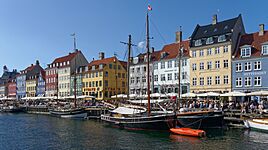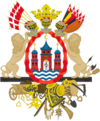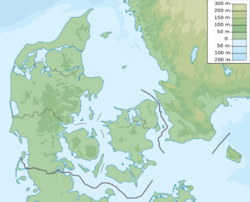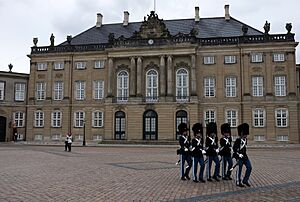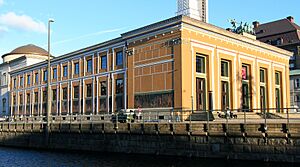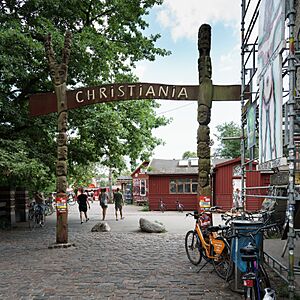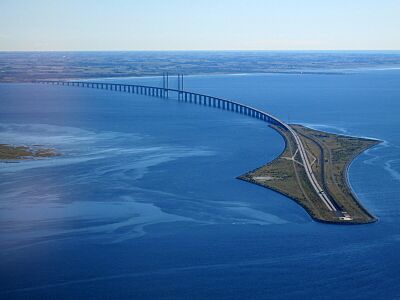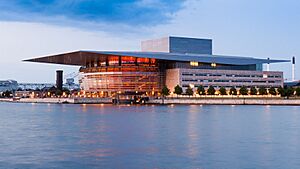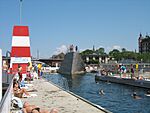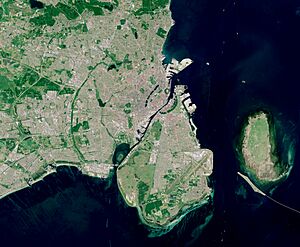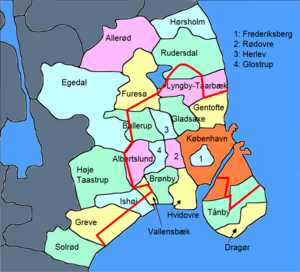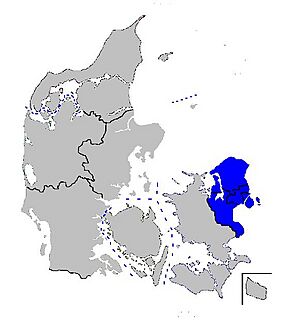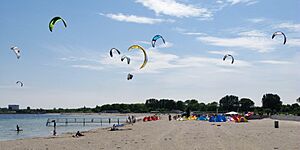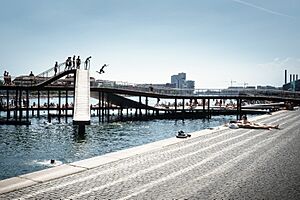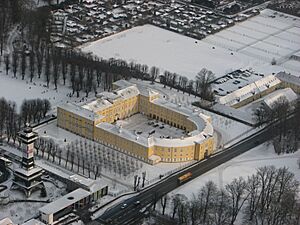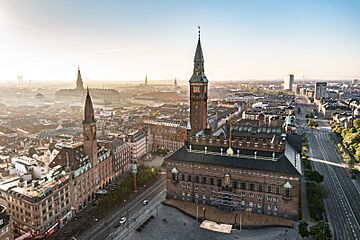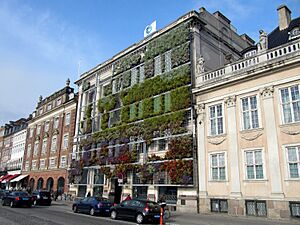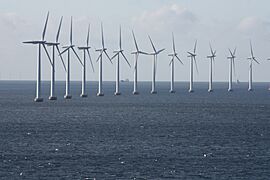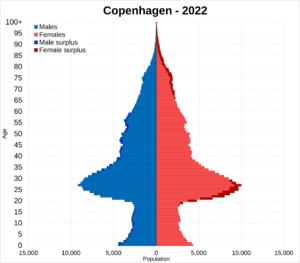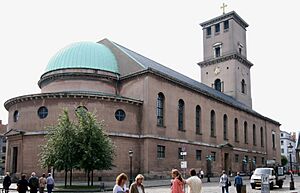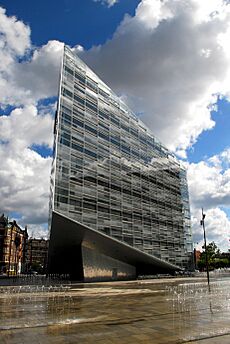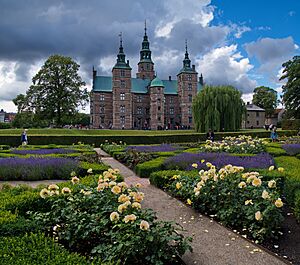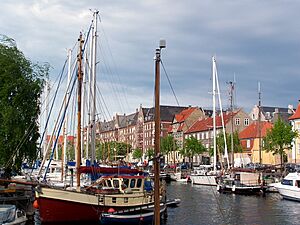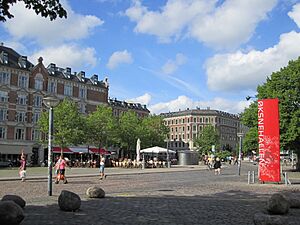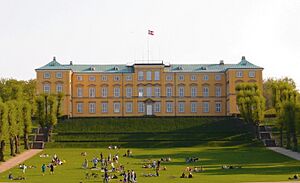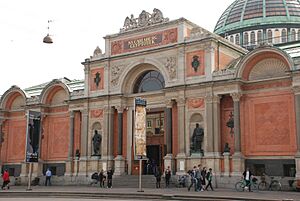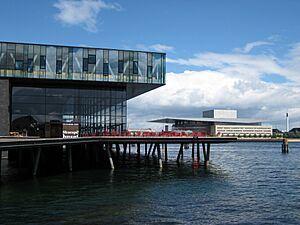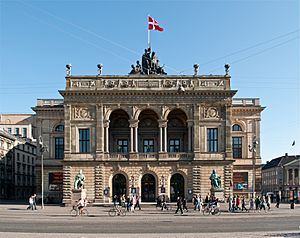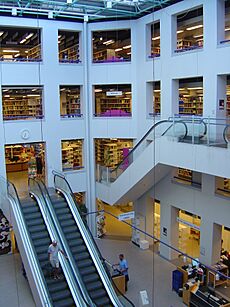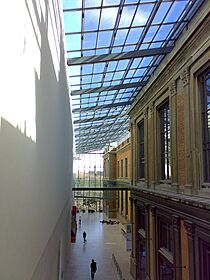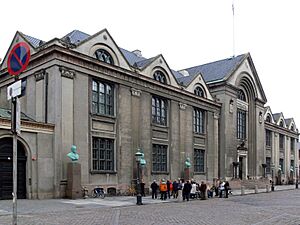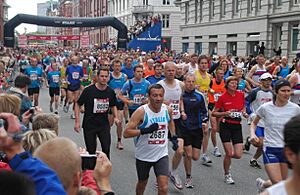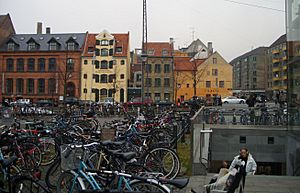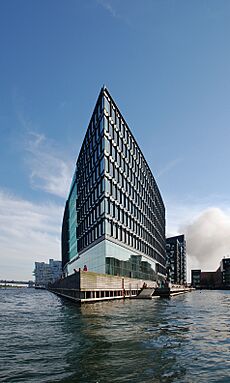Copenhagen facts for kids
Quick facts for kids
Copenhagen
København (Danish)
|
||
|---|---|---|
| City of Copenhagen Københavns Kommune (Danish) |
||
|
|
||
|
||
| Sovereign state | ||
| Constituent Country | ||
| Region | ||
| Municipalities | ||
| Established | 1167 | |
| Area | ||
| • Municipality | 90.01 km2 (34.75 sq mi) | |
| • Urban | 525.50 km2 (202.90 sq mi) | |
| • Metro | 3,371.80 km2 (1,301.86 sq mi) | |
| Highest elevation | 91 m (299 ft) | |
| Lowest elevation | 1 m (3 ft) | |
| Population
(1 January 2025)
|
||
| • Municipality | 667,099 | |
| • Density | 7,298/km2 (18,900/sq mi) | |
| • Urban | 1,396,508 | |
| • Urban density | 2,560.54/km2 (6,631.8/sq mi) | |
| • Metro | 2,135,634 | |
| • Metro density | 633.38/km2 (1,640.4/sq mi) | |
| Demonym(s) | Copenhagener Københavner (Danish) |
|
| Time zone | UTC+01:00 (CET) | |
| • Summer (DST) | UTC+02:00 (CEST) | |
| Postal code |
1050–1799, 2100, 2150, 2200, 2300, 2400, 2450, 2500, 2700, 2720
|
|
| Area code(s) | (+45) 3 | |
Copenhagen (Danish: København) is the capital and largest city in Denmark. It has a population of about 1.4 million people in its urban area. The city is located on two islands, Zealand and Amager. It is separated from Malmö, Sweden, by a narrow body of water called the Øresund strait. The Øresund Bridge connects Copenhagen and Malmö by both train and road.
Copenhagen started as a Viking fishing village around the 10th century. It became the capital of Denmark in the early 1400s. During the 16th century, it was the main city for the Kalmar Union, which ruled most of the Nordic region. Copenhagen grew into an important cultural and economic center in Scandinavia during the Renaissance. By the 17th century, it was a major power center for the Danish government and military.
In the 18th century, Copenhagen faced a terrible sickness and big fires that destroyed much of the city. After these events, major rebuilding efforts took place. New areas like Frederiksstaden were built, and important cultural places like the Royal Danish Theatre were established. During this time, Copenhagen was also a center for the Danish slave trade. In 1807, a British fleet attacked the city during the Napoleonic Wars. After this, the Danish Golden Age brought a beautiful new look to Copenhagen's buildings. After World War II, a plan called the Finger Plan helped new homes and businesses grow along the city's railway lines.
Since the year 2000, Copenhagen has developed a lot in its city life and culture. This happened because of investments in its buildings and services. The city is now the main cultural, economic, and government center of Denmark. It is also a big financial hub in Northern Europe, home to the Copenhagen Stock Exchange. Copenhagen's economy has grown quickly in the service sector, especially in areas like information technology, pharmaceuticals, and clean technology.
With the Øresund Bridge completed, Copenhagen has become more connected with the Swedish area of Scania and its largest city, Malmö. Together, they form the Øresund Region. Copenhagen's cityscape has many bridges connecting its different areas. It is also known for its parks, walking paths, and waterfronts. Popular landmarks include Tivoli Gardens, The Little Mermaid statue, the Amalienborg and Christiansborg palaces, Rosenborg Castle, Frederik's Church, Børsen, and many museums and restaurants.
Copenhagen is home to several universities, including the University of Copenhagen, which was founded in 1479 and is the oldest in Denmark. The city also has famous football clubs like F.C. Copenhagen and Brøndby IF. The annual Copenhagen Marathon started in 1980. Copenhagen is known as one of the most bicycle-friendly cities in the world. The Copenhagen Metro, which opened in 2002, serves the city center. Other train networks like the Copenhagen S-train connect the city center to outer areas. Copenhagen Airport, Kastrup, is the busiest airport in the Nordic countries.
Contents
- What's in a Name?
- A Look Back at Copenhagen's History
- Copenhagen's Location and Landscape
- Copenhagen's Weather
- How Copenhagen is Managed
- People of Copenhagen
- Copenhagen's Economy
- City Layout and Buildings
- Copenhagen's Culture
- Learning in Copenhagen
- Sports in Copenhagen
- Getting Around Copenhagen
- Healthcare in Copenhagen
- Media in Copenhagen
- Sister Cities
- Honorary Citizens
- Images for kids
- See also
What's in a Name?
Copenhagen's Danish name, København, shows its history as a harbor and a place for trade. In Old Norse, an older language, it was called Kaupmannahǫfn, which means 'merchants' harbor'. Over hundreds of years, the name changed to what it is today. The English name "Copenhagen" comes from its Low German name, Kopenhagen.
A Look Back at Copenhagen's History
Early Beginnings
Tools made of flint found in the area show that people lived here as far back as the Stone Age. Many historians believe the town started in the late Viking Age.
Discoveries show that Copenhagen began as a city at least in the 11th century. Its natural harbor and good supply of herring fish attracted fishermen and traders. The first homes were likely near Gammel Strand (meaning 'old shore'). Recent digs for the city's metro system found parts of a large merchant's house from around 1020. An old church with graves from the 11th century was also found.
The first time Copenhagen was mentioned in writing was in the 12th century. It was called Portus Mercatorum, meaning 'Merchants' Harbour'. People traditionally say Copenhagen was founded when Bishop Absalon built a small fort on the island of Slotsholmen in 1167. This is where Christiansborg Palace stands today. The fort was built to protect against attacks from Wendish pirates.
Medieval Times
In 1186, the fort and lands of Hafn (Copenhagen) were given to Bishop Absalon. When he passed away, the land went to the Bishopric of Roskilde. Around 1200, the Church of Our Lady was built, and the town grew around it.
As the town became more important, it was often attacked by the Hanseatic League. In 1368, it was taken over during a war. As fishing, especially for herring, grew in Copenhagen, the city expanded. In 1254, it officially became a city.
When the Kalmar Union (1397–1523) formed between Denmark, Norway, and Sweden, Copenhagen became Denmark's capital around 1416. King Christian I opened the University of Copenhagen on June 1, 1479. It is the oldest university in Denmark.
Growth in the 16th and 17th Centuries
Before the Reformation in 1536, Copenhagen supported the Catholic King Christian II. It was taken over in 1523 by forces supporting Lutheranism. The city's defenses were made stronger with new towers. After a long siege from 1535 to 1536, the city finally gave in to Christian III. In the second half of the 16th century, the city grew wealthy from more trade across the Baltic Sea.
During the rule of Christian IV (1588–1648), Copenhagen grew a lot. He had two important buildings finished on Slotsholmen: the Tøjhus Arsenal and Børsen, the stock exchange. To help international trade, the Danish East India Company was started in 1616. The king also created the Christianshavn area with canals and defenses, inspired by Dutch cities. It was meant to be a trading center but became part of Copenhagen. Christian IV also built Rosenborg Slot and the Rundetårn. In 1658–1659, the city bravely defended itself against a siege by the Swedes.
By 1661, Copenhagen was firmly the capital of Denmark and Norway. All the main government offices, the navy, and most of the army were there. Defenses were improved with the Citadel in 1664 and new parts of Christianshavns Vold in 1692.
The 18th Century
In 1711, Copenhagen lost about 22,000 people to a terrible sickness. The city also suffered from two big fires that destroyed much of its buildings. The Copenhagen Fire of 1728 was the biggest, burning for three days and destroying about 28% of the city. Many people lost their homes. Because of this fire and another in 1795, not many old buildings remain in the modern city.
A lot of rebuilding happened after the fires. In 1733, work began on Christiansborg Palace. In 1749, the beautiful Frederiksstaden district was started. It was designed in the Rococo style, with the Amalienborg Palace at its center. The naval base at Holmen was expanded, and cultural places like the Royal Danish Theatre and the Royal Danish Academy of Fine Arts were established.
During the 18th century, Copenhagen was a center for the Danish slave trade. Merchants from Copenhagen transported many enslaved Africans to the Danish West Indies. Many buildings in the city were built with money made from this trade. In the late 18th century, Copenhagen benefited from Denmark being neutral during wars in Europe. This allowed it to play an important role in trade around the Baltic Sea. After Christiansborg burned down in 1794 and another fire hit the city in 1795, work began on the classical Højbro Plads.
The 19th Century
In 1801, a British fleet attacked the Danish navy near Copenhagen. The battle was very tough, but the British won, taking or sinking most of the Danish ships. This led Denmark to agree not to ally with France.
In 1807, another British fleet attacked Copenhagen, fearing Denmark would join France. They bombed the city from September 2 to 5. This attack killed many civilians and destroyed about 1,000 buildings, including the Church of Our Lady. The Danish navy was given to the British. Denmark then declared war on Britain, starting the Gunboat War.
Despite these wars, Copenhagen soon entered a period of great creativity called the Danish Golden Age. Art and architecture flourished. In the early 1850s, the city's old defenses were opened up. This allowed new homes to be built around The Lakes. By the 1880s, areas like Nørrebro and Vesterbro grew to house people moving to the city for industrial jobs. This expansion was much needed because the old city was crowded and had poor sanitation. From 1886, the western defenses were removed, allowing the harbor to expand. Electricity arrived in 1892, and electric trams in 1897. The population grew from about 120,000 in 1840 to 400,000 by 1901.
The 20th Century
By the early 1900s, Copenhagen was a busy industrial city. Its new city hall and railway station shifted the city's center to the west. New housing areas grew in Brønshøj and Valby.
During First World War, Denmark remained neutral, and Copenhagen benefited from trade. In the 1920s, there were shortages of goods and housing. Plans were made to improve slum areas, and in the 1930s, new housing blocks were built.
World War II
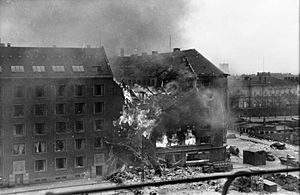
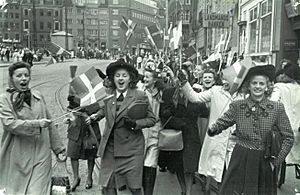
Copenhagen was occupied by German troops from April 9, 1940, until May 4, 1945, during Denmark in World War II. In August 1943, several Danish navy ships were sunk in Copenhagen Harbor to prevent the Germans from using them. Around that time, the Nazis began arresting Jewish people, but most managed to escape to Sweden.
In March 1945, the British Royal Air Force attacked the Gestapo headquarters in Copenhagen. This attack, called "Operation Carthage", was very precise. Sadly, one plane crashed near a school, causing other planes to mistakenly bomb the school. This led to the deaths of 123 civilians, including 87 schoolchildren. However, 18 political prisoners escaped from the Shell Building, and the Gestapo's records were destroyed.
On May 8, 1945, British troops officially liberated Copenhagen.
After the War
After the war, the Finger Plan was introduced in 1947. This plan encouraged new housing and businesses to grow along five "fingers" stretching from the city center, with green areas in between. As the welfare state grew, schools, nurseries, sports facilities, and hospitals were built. In 1971, a former barracks was taken over, leading to the creation of Freetown Christiania.
Car traffic increased, and in 1972, trams were replaced by buses. From the 1960s, pedestrian streets and bike paths were created in the city center. The port of Copenhagen became less active. Copenhagen Airport grew a lot, becoming a major airport for the Nordic countries. In the 1990s, many new homes were built in the harbor area. The national library's Black Diamond building on the waterfront was finished in 1999.
Gallery
-
Freetown Christiania – entrance
The 21st Century
Since 2000, Copenhagen and the Swedish city of Malmö have been connected by the Øresund Bridge. This has made Copenhagen the center of a larger metropolitan area. The bridge has changed public transport and led to a lot of new development on Amager. The city's service and trade industries have grown, and many banks have opened. Universities, especially the University of Copenhagen with its 35,000 students, have also become more important.
A big change for the city was the opening of the Copenhagen Metro in 2002. It expanded until 2007, carrying about 54 million passengers by 2011. The Copenhagen Opera House, a gift to the city, was finished in 2004.
In December 2009, Copenhagen hosted the worldwide climate meeting COP15. In 2019, CNN named Copenhagen the best swimming city. Copenhagen harbor now has 13 official swimming areas.
In July 2022, a shooting at the Field's mall in Copenhagen resulted in three deaths. Police arrested a 22-year-old man.
Copenhagen's Location and Landscape
Copenhagen is part of the Øresund Region, which includes parts of Denmark and Sweden. It sits on the eastern side of the island of Zealand, partly on the island of Amager, and on several small islands. Copenhagen faces the Øresund strait to the east, which connects the North Sea with the Baltic Sea. The Swedish city of Malmö is directly across the strait.
The city center is in the area once surrounded by old defenses, which are now green spaces. Around this center are neighborhoods like Østerbro, Nørrebro, and Vesterbro, built in the late 1800s and early 1900s. Later areas like Valby and Brønshøj were developed from 1920 to 1960, mostly with homes and parks.
Land Features
The central part of the city is mostly flat, formed by ancient ice. Hilly areas to the north and west can rise up to 50 meters (164 feet) above sea level. Near the center are the Copenhagen lakes.
Copenhagen sits on a base of limestone from about 60 to 66 million years ago. During the last ice age, glaciers left a layer of soil up to 15 meters (49 feet) thick.
Beaches and Harbor Baths
Amager Strandpark, opened in 2005, is a 2-kilometer (1.2-mile) long artificial island with 4.6 kilometers (2.9 miles) of beaches. It's just a short bike ride or metro trip from the city center. Another beach, Bellevue Beach, is about 10 kilometers (6.2 miles) from downtown Copenhagen.
Besides beaches, Copenhagen has Harbour Baths along its waterfront. The most popular one is at Islands Brygge, known for its design.
Copenhagen's Weather
Copenhagen has an oceanic climate, meaning its weather is often influenced by low-pressure systems from the Atlantic Ocean. This causes changeable weather throughout the year. Rain is moderate, with slightly more from July to September. Snow mainly falls from late December to early March.
July is the sunniest month, with over seven hours of sunshine a day. It's also the warmest, with average daytime highs of 22.2 °C (72.0 °F). In contrast, November to February have much less sunshine. February is the driest month. Sometimes, Copenhagen can get a lot of snow in 24 hours during winter, and summer temperatures can reach 33 °C (91 °F).
Because Copenhagen is far north, daylight hours change a lot between summer and winter. In summer, the sun is up for over 17 hours. In winter, it's only up for about 7 hours.
How Copenhagen is Managed
Copenhagen's urban area includes the municipalities of Copenhagen, Frederiksberg, and others. These are part of the Capital Region of Denmark. Municipalities are in charge of many public services, like planning, housing, roads, and social security. They are run by a mayor and a council.
Copenhagen Municipality is the largest, with the historic city at its heart. The Copenhagen City Hall is where the municipal council meets. Frederiksberg is the second largest municipality.
Copenhagen Municipality is divided into ten districts. Some neighborhoods include Slotsholmen, Frederiksstaden, and Freetown Christiania.
Law and Safety
Most of Denmark's main courts are in Copenhagen. The Copenhagen Court House is the largest city court in Denmark. The Supreme Court of Denmark, the country's highest court, is located in Christiansborg Palace.
The Danish National Police and Copenhagen Police headquarters are in the Politigården building. The Copenhagen Fire Department is the largest fire brigade in Denmark. It started in 1687 and became a municipal service in 1870.
Green City Planning
Copenhagen is known as one of the most environmentally friendly cities in the world. It has been praised for its green economy. In 2001, a large offshore wind farm was built near Copenhagen, producing about 4% of the city's energy. Years of work on sewage treatment have made the harbor water clean enough for swimming.
Copenhagen aims to be carbon-neutral by 2025. This means reducing electricity use in buildings and cutting heat consumption. Renewable energy, like solar panels, is becoming common. District heating will also be carbon-neutral by 2025. The city plans for 75% of trips to be by walking, biking, or public transport by 2025. They also want 20–30% of cars to run on electricity or biofuel.
City planners focus on climate issues and low-energy standards. They also design streets and squares to encourage cycling and walking.
People of Copenhagen
Population by origin background in 2022 Danish (73.7%) Other European (12.9%) Asian (8.2%) African (3.0%) Others (2.2%)
Copenhagen is the most populated city in Denmark. The Municipality of Copenhagen has about 644,431 people (as of 2022). The population grew a lot in the 1990s and early 2000s, partly due to people moving there from other countries. In 2022, about 73.7% of the population was of Danish descent. The rest were from other countries or descendants of recent immigrants.
The urban area of Copenhagen has a larger population of about 1.28 million. The wider Metropolitan Copenhagen has over 2 million people. Since the Øresund Bridge opened, more people travel between Zealand and Scania in Sweden, creating a larger connected region with 4.1 million people. In Copenhagen, more than half of households have only one adult.
Religions in Copenhagen
Most people (56.9%) in Copenhagen are members of the Lutheran Church of Denmark. The Church of Our Lady is the National Cathedral. There are also other Christian groups.
More people moving to Copenhagen from other countries has led to more religious diversity. Islam is the second largest religion, with about 10% of the population. Many Muslims in Denmark live in Copenhagen. There are also about 7,000 Jewish people in Denmark, mostly in Copenhagen, where there are several synagogues. The first synagogue in Copenhagen was built in 1684.
Living in Copenhagen
Copenhagen often ranks high in surveys for its quality of life. Its stable economy, good education, and social safety make it an attractive place. Even though it's one of the world's most expensive cities, it's also very livable. This is due to its public transport, bike-friendly features, and environmental policies. In 2013, Monocle magazine called Copenhagen the "most liveable city" because of its open spaces, lively streets, and focus on community and culture. In 2024, it was ranked the second most livable city by the Economist Intelligence Unit.
Copenhagen's Economy
Copenhagen is Denmark's main economic and financial centre. Its economy is mostly based on services and trade. In 2010, most of Copenhagen's 350,000 workers were in the service sector, like transport, communication, trade, and finance. Less than 10,000 worked in manufacturing. The public sector, including education and healthcare, employed about 110,000 people. From 2006 to 2011, Copenhagen's economy grew by 2.5%, while the rest of Denmark's economy shrank. In 2017, the wider Capital Region of Denmark had a large economy.
Copenhagen is a leader in the global green economy. The Copenhagen region makes up almost 40% of Denmark's economic output and has had steady growth. Denmark's economy is among the top 10 in the world. The city has grown while also improving its environment and moving towards a low-carbon economy.
Many financial companies and banks have their main offices in Copenhagen, including Danske Bank and Nykredit. The Copenhagen Stock Exchange was founded in 1620. Copenhagen is also home to big international companies like A.P. Møller-Mærsk and Carlsberg. The city encourages the growth of businesses in new areas like information technology, biotechnology, and clean technology.

Life science is a very important sector, with a lot of research and development. Medicon Valley is a leading life sciences area in Europe, connecting Copenhagen and Sweden. Many big Danish companies like Novo Nordisk and Lundbeck, which are among the largest pharmaceutical companies in the world, are in this area.
Shipping is another key industry. Maersk, the world's largest shipping company, has its headquarters in Copenhagen. The city has an industrial harbor, Copenhagen Port. It has grown since 1990 after merging with Malmö harbor. The ports handle a lot of freight that is then sent to the Baltic countries.
Copenhagen has some of the highest wages in the world. However, high taxes mean that the money people take home is less. Denmark's flexible hiring and firing laws make it attractive for foreign companies to invest in Copenhagen.
Tourism in Copenhagen
Tourism is a big part of Copenhagen's economy. Visitors are drawn to the city's harbor, cultural sites, and famous restaurants. Since 2009, Copenhagen has been one of the fastest-growing tourist destinations in Europe. The number of hotel stays has increased significantly.
In 2010, tourism from short city trips brought in about DKK 2 billion. In 2015, 680,000 cruise passengers visited the port. In 2019, Lonely Planet ranked Copenhagen as the top city to visit.
City Layout and Buildings
Copenhagen's look today is shaped by its long history as a regional center. It has many different districts, each with its own unique feel. Other special features of Copenhagen include its many waterways, parks, and bicycle paths on most streets.
Architecture and Design
The oldest part of Copenhagen's inner city is called Middelalderbyen (the medieval city). But the most famous district is Frederiksstaden, built during the time of Frederick V. It has the Amalienborg Palace at its center and is known for the dome of Frederik's Church and elegant 18th-century Rococo mansions. The inner city also includes Slotsholmen, an island with Christiansborg Palace, and Christianshavn with its canals. Børsen and Frederiksborg Palace are examples of the Dutch Renaissance style. Around the historic center are residential areas like Vesterbro and Nørrebro, built in the late 1800s when the city was allowed to grow beyond its old defenses.
Copenhagen is sometimes called "the City of Spires" because of its flat skyline broken by church and castle towers. The most famous is the Baroque spire of the Church of Our Saviour, which has an outside spiral staircase you can climb. Other important spires are on Christiansborg Palace, the City Hall, and the former Church of St. Nikolaj. The "dragon spire" of Børsen is named for its design that looks like four dragon tails.
Copenhagen is known worldwide for its excellent urban planning. Its lively city center has modern buildings, inviting public spaces, and lots of activity. These results come from careful planning in the second half of the 20th century.
Recently, there has been a boom in modern architecture in Copenhagen, with buildings by both Danish and international architects. Monocle magazine named Copenhagen the World's best design city 2008.
The city's growth in the early 1900s was shaped by industry. After World War II, Copenhagen changed its medieval center to make way for cars. However, in recent years, the city has focused on separating different land uses, which means people often need to travel by car to reach different places.
The growth in urban development has changed the city's skyline. While the historic center remains free of tall buildings, several areas have seen big new developments. Ørestad, near Copenhagen Airport, now has one of Scandinavia's largest malls and many office and residential buildings.
Parks, Gardens, and Zoo
Copenhagen is a green city with many parks. King's Garden (Kongens Have), the garden of Rosenborg Castle, is the oldest and most visited. It was first designed by Christian IV in 1606. Over 2.5 million people visit it each year. It has sculptures and temporary art exhibits. Also in the city center are the Botanical Gardens, known for their large 19th-century greenhouses. Fælledparken, at 58 hectares (143 acres), is Copenhagen's largest park.
It's popular for sports and hosts annual events like free opera concerts and the Copenhagen Historic Grand Prix for antique cars. A historic green space is Kastellet, a well-preserved Renaissance fort that is now a park. Another popular park is the Frederiksberg Gardens, a 32-hectare (79-acre) romantic park. It has a colony of tame grey herons and offers views of the elephants at the nearby Copenhagen Zoo. Langelinie, a park along the inner Øresund coast, is home to The Little Mermaid statue.
Many cemeteries in Copenhagen also serve as parks for quiet activities. Assistens Cemetery, where Hans Christian Andersen is buried, is an important green space for the Inner Nørrebro district. Vestre Kirkegaard is Denmark's largest cemetery and has many groves, lawns, and paths.
Copenhagen's official policy is that by 2015, all citizens should be able to reach a park or beach on foot in less than 15 minutes. This has led to new parks, like the Superkilen in Nørrebro.
Famous Places by District
Indre By (Inner City)
The historic center, Indre By, has many of Copenhagen's most popular landmarks. Frederiksstaden, built in the 18th century, features the four mansions of Amalienborg, the royal home, and the large-domed Marble Church. Across the water from Amalienborg is the 21st-century Copenhagen Opera House. South of Frederiksstaden, the Nyhavn canal has colorful 17th and 18th-century houses, now home to lively restaurants. The canal leads to Kongens Nytorv, a large square laid out in 1670. Important buildings here include Charlottenborg Palace (for art exhibitions) and the Royal Danish Theatre. Other landmarks in Indre By include the parliament building Christiansborg, the City Hall, and Rundetårn, an old observatory. Strøget, one of the world's oldest and longest pedestrian streets, runs for 3.2 kilometers (2 miles) from Rådhuspladsen to Kongens Nytorv. It's full of shops, cafes, and street performers. Rosenborg Castle was built by Christian IV in 1606 as a summer home. It holds the Danish crown jewels.
Christianshavn
Christianshavn is southeast of Indre By, across the harbor. Christian IV developed this area in the early 17th century, inspired by Amsterdam. He created canals within its ramparts, which are still well-preserved. The canals, with houseboats, are a main attraction. Another interesting place is Freetown Christiania, a large area that started when people moved in during student protests in 1971. It still has some self-rule. Other notable buildings include the Church of Our Saviour with its spiraling steeple and the beautiful Rococo Christian's Church. The North Atlantic House, once a warehouse, now shows culture from Iceland and Greenland and houses the famous Noma restaurant.
Vesterbro
Vesterbro, southwest of Indre By, starts with the Tivoli Gardens. This is the city's top tourist attraction, with rides, a theater, and restaurants. The Carlsberg neighborhood has interesting parts of the old brewery, like the Elephant Gate. The Tycho Brahe Planetarium is by Skt. Jørgens Sø. Halmtorvet, the old hay market behind the Central Station, is now a popular area with cafes. The former cattle market, Øksnehallen, is now an art exhibition center. The Radisson Blu Royal Hotel, built by Arne Jacobsen, was once the tallest hotel in Denmark. Det Ny Teater (the New Theatre) is a popular place for musicals.
Nørrebro
Nørrebro, northwest of the city center, has changed from a working-class area to a diverse, lively place with antique shops and international restaurants. Much of the activity is around Sankt Hans Torv. Copenhagen's historic cemetery, Assistens Kirkegård, is the resting place of famous people like Hans Christian Andersen. Locals also use it as a park.
Østerbro
Just north of the city center, Østerbro is an upscale district with many beautiful mansions, some now embassies. The district stretches to the waterfront where The Little Mermaid statue can be seen from Langelinie. This statue, inspired by Hans Christian Andersen's fairy tale, was unveiled in 1913. Near the Little Mermaid is the old Citadel (Kastellet), one of northern Europe's best-preserved forts. The large Gefion Fountain shows a Nordic legend.
Frederiksberg
Frederiksberg, a separate municipality within Copenhagen, is west of Nørrebro and Indre By. Its landmarks include Copenhagen Zoo, founded in 1869, and Frederiksberg Palace. The palace was built as a summer home and overlooks the large Frederiksberg Gardens with its waterfalls and decorative buildings. Frederiksberg Allé, a wide tree-lined street, has long been known for theaters and entertainment.
Amagerbro
Amagerbro is southeast of Christianshavn on northern Amager. The old city moats separate these areas. The main street, Amagerbrogade, has many shops and restaurants. Amagerbro was built in the early 1900s with typical 4–7 story buildings.
Other Districts
Near Copenhagen Airport on the Kastrup coast, The Blue Planet opened in March 2013. It is the largest aquarium in Scandinavia. Grundtvig's Church, in the northern suburb of Bispebjerg, was finished in 1940. Its unique design resembles a church organ.
Copenhagen's Culture
Copenhagen is Denmark's cultural center and a major hub in Scandinavia. Since the late 1990s, it has become a metropolitan city with international appeal. This is due to big investments in buildings and culture, and the work of successful Danish architects, designers, and chefs. Copenhagen Fashion Week happens every February and August.
Museums to Explore
Copenhagen has many museums. The National Museum of Denmark is Denmark's largest museum of archaeology and cultural history. Denmark's National Gallery is the national art museum, with collections from the 12th century to today. It features Danish and international artists.
Another important art museum is the Ny Carlsberg Glyptotek, founded by Carlsberg's Carl Jacobsen. It focuses on ancient Egyptian, Roman, and Greek sculptures, as well as a large collection of Rodin sculptures. It also has paintings by Impressionist and Post-Impressionist artists like Monet and van Gogh.
Louisiana is a Museum of Modern Art north of Copenhagen. It has a collection of over 3,000 works, including pieces by Picasso. The Danish Museum of Art & Design shows Danish design and international crafts.
Other museums include the Thorvaldsens Museum, dedicated to sculptor Bertel Thorvaldsen, and the Cisternerne museum, an art space in old underground water tanks.
Entertainment and Shows
The new Copenhagen Concert Hall opened in January 2009. Designed by Jean Nouvel, it has four halls, with the main one seating 1,800 people. It is home to the Danish National Symphony Orchestra. The Tivoli Concert Hall is another important place for classical music. The Copenhagen Opera House (Operaen), designed by Henning Larsen, opened in 2005 and is one of the most modern opera houses in the world. The Royal Danish Theatre also puts on operas and plays. It is home to the Royal Danish Ballet, one of Europe's oldest ballet groups.
Copenhagen has a lively jazz scene. Many American jazz musicians moved to Copenhagen in the 1960s. Every July, the Copenhagen Jazz Festival fills the city with jazz concerts. It's one of Europe's top jazz festivals, with about 900 concerts at 100 places.
The largest venue for popular music is Vega in the Vesterbro district. It was named "best concert venue in Europe" by Live magazine. Every September, the Festival of Endless Gratitude (FOEG) features indie and experimental pop music.
For free entertainment, you can walk along Strøget, especially between Nytorv and Højbro Plads. In the late afternoon and evening, it's full of musicians, magicians, and other street performers.
Books and Libraries
Most of Denmark's major publishing houses are in Copenhagen. Many important Danish writers, like Hans Christian Andersen (famous for his fairy tales) and philosopher Søren Kierkegaard, lived much of their lives in Copenhagen.
The Royal Library, part of the University of Copenhagen, is the largest library in the Nordic countries. It has almost every Danish book printed since 1482. Copenhagen's public library system has over 20 branches, with the largest being the Central Library on Krystalgade.
Art and Sculptures
Copenhagen has many art museums and galleries. These include the National Gallery of Denmark and the Hirschsprung Collection, which focuses on 19th and early 20th-century art. Kunsthal Charlottenborg shows contemporary art. The Arken Museum of Modern Art is in southwestern Ishøj.
Many famous sculptures can be seen in the city. Besides The Little Mermaid, there are historic statues like Jacques Saly's Frederik V on Horseback in Amalienborg Square. Rosenborg Castle Gardens has several sculptures, including one of Hans Christian Andersen.
Copenhagen is thought to have invented the photomarathon competition, which has been held there every year since 1989.
Food and Drink
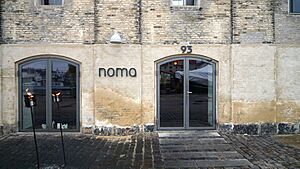
As of 2014, Copenhagen had 15 Michelin-starred restaurants, the most in Scandinavia. The city is becoming known worldwide as a great place for food. Restaurants like Noma and Geranium have received top honors. Noma was named the Best Restaurant in the World several times, sparking interest in New Nordic Cuisine.
Besides fancy restaurants, Copenhagen offers many Danish, international, and experimental eateries. You can find places serving traditional Danish open sandwiches, called smørrebrød. Danish pastry can be bought from many bakeries. Denmark's oldest still-operating bakery, Conditori La Glace, was founded in 1870.
Copenhagen has a long history with beer. Carlsberg beer has been brewed since 1847. In recent years, there has been a big increase in microbreweries in Denmark, many of them in Copenhagen. Some, like Nørrebro Bryghus, are also brewpubs where you can eat.
Nightlife and Festivals
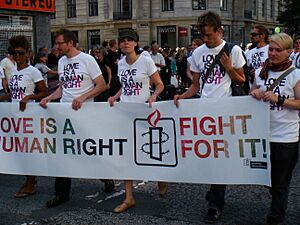
Copenhagen has many restaurants and bars. Nightclubs stay open late. Denmark has a very open alcohol culture, but drinking and driving is taken seriously. Areas like Istedgade in Vesterbro and Sankt Hans Torv in Nørrebro are known for their nightlife.
Copenhagen hosts several festivals, mostly in the summer. The Copenhagen Carnival happens every year during the Whitsun holiday, with bands and dancers. Since 2010, Copenhell, a heavy metal festival, has taken place at the old B&W Shipyard. Copenhagen Pride is an LGBT pride festival every August, with many activities around the city. Copenhagen Distortion is one of Europe's biggest street festivals, with many people joining parties in early June.
Fun Parks
Copenhagen has the oldest and third-oldest amusement parks in the world.
Dyrehavsbakken, a fairground established in 1583, is north of Copenhagen in a forest. It's the oldest amusement park still running in the world. There's no entrance fee.
The Tivoli Gardens is an amusement park in central Copenhagen. It opened in 1843, making it the third-oldest amusement park in the world. Its rides include the oldest operating rollercoaster from 1915 and the oldest ferris wheel still in use, opened in 1943. Tivoli Gardens also hosts various shows and cultural events.
Learning in Copenhagen
Copenhagen has over 94,000 students in its largest universities. The University of Copenhagen is Denmark's oldest university, founded in 1479. It welcomes many international students each year. In 2016, it was ranked 30th in the world.
The Technical University of Denmark is just north of Copenhagen. It was ranked as one of Northern Europe's leading technical universities in 2013. The IT University of Copenhagen focuses on technology and its impact on society and business.
The Danish Academy of Fine Arts has taught arts for over 250 years. It includes schools for visual arts, architecture, design, and conservation. Copenhagen Business School (CBS) is a business school in Frederiksberg.
Sports in Copenhagen
Copenhagen has many sports teams. The main football teams are FC København and Brøndby. FC København plays at Parken.
Copenhagen has several handball teams, a very popular sport in Denmark. There are also ice hockey teams.
Rugby union and Rugby league are also played in Copenhagen. The Danish Australian Football League, based in Copenhagen, is the largest Australian rules football competition outside of English-speaking countries.
The Copenhagen Marathon, an annual running event, started in 1980. The Round Christiansborg Open Water Swim Race is a 2-kilometer (1.2-mile) swimming competition in the harbor each August. Copenhagen hosted the 2011 UCI Road World Championships for cycling in September 2011, using its bike-friendly roads.
Getting Around Copenhagen
The greater Copenhagen area has a very good transportation system, making it a hub in Northern Europe. Copenhagen Airport, opened in 1925, is Scandinavia's largest airport. It's connected to the city center by metro and train.
Roads, Rails, and Ferries
Copenhagen has a large road network, including highways that connect it to other parts of Denmark and to Sweden via the Øresund Bridge. Cars are still the most common way to get around the city, but this can cause traffic jams during busy hours. The Øresund train connects Copenhagen with Malmö all day, every day.
Copenhagen also has a daily ferry service to Oslo, Norway. In 2012, Copenhagen Harbor handled 372 cruise ships and 840,000 passengers.
The Copenhagen S-Train, Copenhagen Metro, and regional train networks are used by about half of the city's passengers. The rest use buses. Nørreport Station is a major hub for all these services. Copenhagen Central Station is the main hub for Denmark's railway network.
The Copenhagen Metro expanded a lot with the opening of the City Circle Line (M3) in September 2019. This new line connects all inner parts of the city by metro, including the Central Station, and added 17 new stations. In March 2020, the Nordhavn extension of the Harbour Line (M4) opened. These new metro lines are part of the city's plan to encourage public transport and cycling instead of driving.
Copenhagen is known for how well it combines public transport and city development. Its Finger Plan is seen as a great example of a "transit metropolis," where areas around train stations are developed for easy access.
Cycling in Copenhagen
Copenhagen has been ranked as one of the most bicycle-friendly cities in the world since 2015. There are more bicycles than people! In 2012, about 36% of people living in the city cycled to work or school. Copenhagen's cyclists cover 1.27 million kilometers (789,000 miles) every workday. The city has extensive bicycle paths, with 400 kilometers (249 miles) of lanes not shared with cars or pedestrians. Sometimes, these bike lanes even have their own traffic lights.
Healthcare in Copenhagen
Promoting health is important for Copenhagen's city government. Their "Long Live Copenhagen" plan aims to increase how long citizens live, improve their quality of life through better health, and encourage more productive lives. The city wants to encourage people to exercise and reduce smoking and drinking.
Copenhagen University Hospital includes several hospitals, like Rigshospitalet and Bispebjerg Hospital. Rigshospitalet started in 1757 and became state-owned in 1903. It has 1,120 beds and treats many patients each year. It aims to be the top specialist hospital in Denmark, with a lot of research into cancer treatment and surgery. Bispebjerg Hospital was built in 1913 and serves about 400,000 people. Other large hospitals in the city include Amager Hospital and Herlev Hospital.
Media in Copenhagen
Many Danish media companies are in Copenhagen. DR, the main Danish public broadcasting company, moved to its new headquarters, DR Byen, in 2006 and 2007. TV2 also has its Copenhagen offices in a modern media building. The two national daily newspapers, Politiken and Berlingske, are based in Copenhagen. Other important media companies include Aller Media, the largest publisher of magazines in Scandinavia, and Gyldendal, the largest Danish book publisher.
Copenhagen has a big film and television industry. Nordisk Film, started in 1906, is the oldest continuously operating film production company in the world. It now runs the 17-screen Palads Cinema in Copenhagen. Filmbyen (movie city), in a former military camp, houses several movie companies and studios. Zentropa is a film company co-owned by director Lars von Trier. He helped start the Dogme Movement. CPH:PIX is Copenhagen's international feature film festival, held in mid-April. CPH:DOX is an international documentary film festival every November.
Sister Cities
Copenhagen is connected with these cities:
Honorary Citizens
People given the honorary citizenship of Copenhagen:
| Date | Name | Notes |
|---|---|---|
| 21 November 1838 | Bertel Thorvaldsen (1770–1844) | Danish sculptor |
While honorary citizenship is no longer given, three people have been named honorary Copenhageners (æreskøbenhavnere):
| Date | Name | Notes |
|---|---|---|
| 16 June 1967 | Poul Reumert (1883–1968) | Danish actor |
| 16 June 1967 | Victor Borge (1909–2000) | Danish comedian |
| 16 June 1967 | Steen Eiler Rasmussen (1898–1990) | Danish architect |
Images for kids
-
The RAF's bombing of the Gestapo headquarters in March 1945
-
People celebrating the liberation of Denmark in Copenhagen, May 5, 1945.
-
Scandinavian headquarters for the Swiss pharmaceutical company Ferring Pharmaceuticals
-
Copenhagen Pride Parade, 2008
See also
 In Spanish: Copenhague para niños
In Spanish: Copenhague para niños







